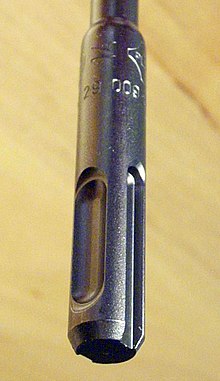SDS (drill shaft)
The term SDS describes a drill shank system for striking and rotating power tools such as drills and rotary hammers . With this insert system, the drill shank is provided with special grooves that ensure better power transmission. In contrast to other insertion systems, the SDS drill shank enables drills and chisels to be changed quickly and without tools .
The abbreviation SDS has several meanings. The system was originally developed by Bosch under the name Steck-Dreh-Sitz and later further developed under the name Clamping by System . Today Bosch uses the term Special Direct System on an international level .
Emergence
With the increasing spread of electric drills and rotary hammers in the 1960s, manufacturers developed different, incompatible drill shaft systems and tool holders. In 1967 , the Hilti company introduced a 10 mm insertion system for light machines, the Hilti TE holder. In 1975, the Robert Bosch company developed the "SDS-plus" insert system with a uniform shaft diameter of 10 mm. One advantage of this further development was that the SDS-plus drills also fit into the TE-C holder of the Hilti machines.
technology
With the Hilti TE mount, engaging rollers (instead of the balls) also transmit torque by means of the flatter grooves (with the semicircular cross-section), which only limit the axial movement with SDS. The weakness of the TE drills was the wear and tear on the extremely stressed edges of these grooves, which in extreme cases led to material warping (beard formation), so that the tools sometimes jammed in the holder.
The drill locking and the torque transmission (with 60 mm² contact surface) take place separately from each other with SDS and are almost wear-free. The drill is locked by means of two opposing grooves (semicircular cross-section), into each of which a ball integrated in the chuck engages. The torque , on the other hand, is transmitted via two grooves that run right through to the end , into which bar-shaped elevations (webs) in the chuck engage with a form-fit. When the drill moves axially, the ball rolls off and the webs slide in the grooves. During hammer drilling, usually only a small part of the total of 13 mm longitudinal play is used.
Variants SDS-max and SDS-quick
Patents for SDS-plus have expired, so the offer is no longer limited to Bosch. Further technical developments of the patented holder are not on the market, but variants with smaller and larger shaft diameters. These variants are not interchangeable.
| designation | Shank transit knife |
Support surface for torque transmission |
description |
|---|---|---|---|
| SDS max | 18 mm | 160 mm 2 | for heavy rotary hammers, now largely replaces older mounting systems (splined shaft, hexagon) |
| SDS top | 14 mm | was developed by Bosch for smaller machines with ever higher performance no market success, even Bosch has not offered a rotary hammer with SDS-top since 2009 |
|
| SDS (-plus) | 10 mm | 60 mm 2 | Developed by Bosch in 1975, original and first variant |
| SDS-quick | 6.8 mm | Introduced by Bosch in 2011, only for Bosch-Uneo and Bosch-Uneo Maxx cordless rotary hammers |
Web links
Individual evidence
- ↑ a b Development of SDS-plus and SDS-max at Bosch. Retrieved July 15, 2013.
- ↑ svh24.de: Differences between SDS-plus, SDS-max and SDS-quick. In: svh24. Retrieved February 12, 2019 .
